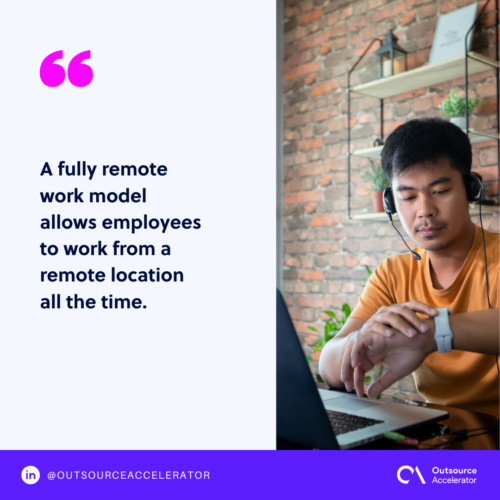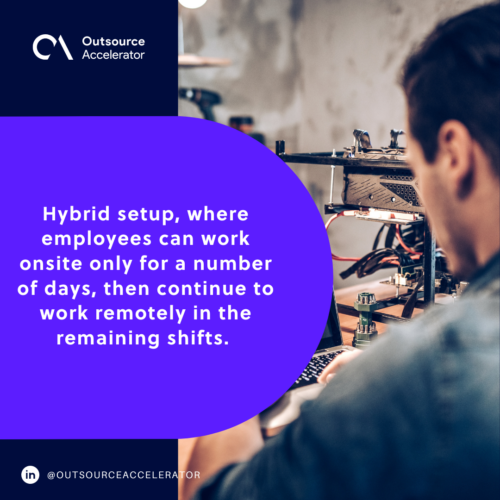Work models: what suits your company the best?

Digitalization is effectively taking over our daily lives. From our personal to professional endeavors, the access to technology is always easily grasped that it can already be used anytime and anywhere.
It has also redefined the working arrangements of companies and its employees. With the emergence of online workspaces such as Adobe, Microsoft, and Google, new and modernized work models rose among the workforce.
In this article, we will be tackling this new work setup, its types, and the most suitable one for your business.
What is a work model?
A work model outlines a business’ daily functions and depicts the working arrangements for its workforce. This guides the management in determining the workforce’s roles and responsibilities, delegating their daily tasks, making certain that they are accomplished and carried out accurately.

Different company industries implement different work models, depending on how crucial or heavy their operations are. In some cases, different departments of a single company also have various work arrangements, also depending on their workload.
The traditional work model that most companies follow is the 40-hour workweek, where employees worked onsite.
However, with the prevalence of online communication platforms and productivity tools, new work models are created and are since then practiced by companies like Spotify.
What are the types of work models?
There are different types of work models that your company can implement. To help you decide which is the best one for your business, here’s a brief background of each:
Fully remote
A fully remote work model allows employees to work from a remote location all the time. There’s no actual workplace or office to report to, which means they can work anywhere from the world.

However, some companies provide a venue when there’s a need for face-to-face meetings and training, or require a designated office location at the employee’s discretion (ex. home office).
This is the most utilized work model when the pandemic happened. Many corporations have opted to work fully remote back in 2020 when the virus was at its peak.
Advantages of this work model include:
- Improved work-life balance
- Access to a global talent pool
- On-time schedule because of no commute times
Meanwhile, the disadvantages of this model include:
- Home distractions
- Estranged company culture
Onsite environment
Onsite work model entails all employees to work at their designated workplace everyday. All tasks must be completed onsite and with collaboration with workmates sometimes.

While this is purely executed at the office, employees can still opt for remote work only when there are unforeseen circumstances that hinder them from reporting onsite.
The onsite work model typically requires the workforce to be present at the office during specific hours set by the company. However, some companies now also offer flexibility by offering part-time and compressed onsite shifts.
Today, some companies are slowly shifting back to this traditional work model.
These are some of the advantages of working onsite:
- Real-time communication
- Great team dynamic/collaboration
- Ability to supervise the entire workforce
Its disadvantages are:
- Office politics
- Smaller job pool
- Reluctance to work
Hybrid setup
A mix between remote and onsite work, this work model provides the workforce to experience both setups. As the name suggests, hybrid work model is implemented in different companies, and here are 2 major ways:
Hybrid setup, where employees can work onsite only for a number of days, then continue to work remotely in the remaining shifts. For example, the workforce is only required to work at the office 3 days a week, then they can continue working remotely in the last 2 days.

Skeletal setup, where only a percentage of the entire workforce will be tasked to work onsite. For example, 50% of your team will be working onsite the whole week, while the other 50% remains to work remotely.
Advantages in working in a hybrid setup:
- Increased productivity
- Enough socialization between colleagues
- Better employment opportunities
However, these are the disadvantages:
- Communication gap between employees
- Not suitable for all industries
- Burnout-inducer
Deskless worker
Similar to the fully remote work model, deskless workers do their jobs without the need to attend a workplace. They can accomplish their tasks in any location as long as they have a device and access to the Internet.
Oftentimes, these deskless workers only work on one, big project at a time that needs to be turned in in a specific timeframe.
A deskless worker’s advantages are:
- Improved productivity
- Enhanced work-life balance
These are the disadvantages:
- Poor coordination with the management
- Lack of recognition and acknowledgement
Tips on choosing the best work model
Consider these tips in choosing the best work model for your company:
Collaboration with employees
A single work model isn’t implemented forever. The company and workforce culture change over time, so companies should always exert an effort in studying the current situation of the team to improve the work environment.
Find out the best work model for your business by collaborating with its employees. Consider their job roles, the weight of their tasks, and their personal experiences in working to identify which is the most suitable setup for them.
Some may opt to work remotely or onsite due to personal matters, and it’s up to your company to address them.
Determination of costs
Implementing these work models requires an additional effort that involves finances. A great amount of money should be invested in whatever work model you choose because the entire company needs to be transitioned.
For example, companies may have to purchase additional devices and softwares for employees who work remotely or include transportation allowances for those who work onsite.
These are the factors you should consider before choosing a work model for your company. Level out their costs and decide from there which will be the most effective one.
Consideration of expectation
These work models vary in expectation in terms of professionalism. When transitioning to a new work model, the company should allot time for its employees to adjust to the new structure. Bombarding them with new rules and regulations will only disrupt their productivity and negatively affect the entire workforce.
Your company may ease down on their expectations for the first few weeks. When you’re transitioning from a fully remote to onsite environment, you can start small by allowing them to dress more casually than professionally.
Choose the right work model for you and your employees
There are a few work models that your company can choose to implement to improve the operations of your business. Especially now in the new normal era, it’s easy to go back to our usual environments.
However, not all are suitable for you and your employees. There are a lot of factors to consider, just like what was mentioned above.
The management and the workforce must work together. Look after your employees and their welfare without compromising the effectiveness of your business by applying the best work model.







 Independent
Independent




